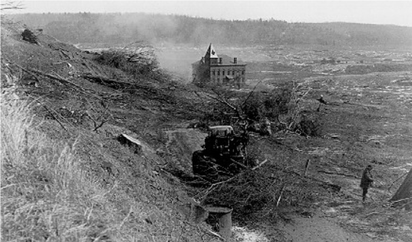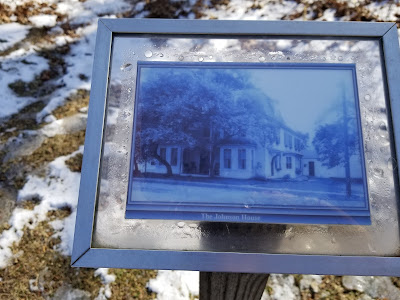 |
| View east toward the Potomac Valley from Hoye-Crest (my photo) |
Today's post goes back to a hike I did on Memorial Day 2017, when I decided to visit 7 state high points on my way home from an event in Illinois. Six of these only involved short walks from my car to the benchmark, as is typical for high points in the East and Midwest. Not Maryland. No, Hoye-Crest on the ridge known as Backbone Mountain requires a hike, and a steep one at that. But the difficulty is still moderate and most people can make the trip (there's even a bench at the top to rest at!). Maryland is one of only 2 state high points where the main trailhead is in another state (along US Route 219 in West Virginia). Less than 1/2 mile round trip of the hike is in Maryland itself and the summit is 400 feet east of the border. Many of these pictures are not my own, as I did not make the decision to start blogging until after I took this hike, and conditions may differ slightly.
 |
Sign on US 219 (silversummit, SummitPost, 2015)
Source: http://www.summitpost.org/trailhead-is-on-the-right/957276/c-152048 |
From the parking spot on the SB shoulder of US 219, there's a short road walk to the trailhead, which is located on the east side of the road opposite the "Maryland High Point" sign. There's a short walk along an old woods road (you could park up here if you have a car with 4WD), then the well-worn high point trail breaks off to the left. In West Virginia, the trail is marked with "blazes" consisting of "HP" spray-painted on trees. Not fancy, but effective. It's a steady climb up the ridge and a sharp turn to the south of over 90 degrees marks the halfway point. We continue climbing, roughly parallel to and just west of the state line. A hairpin turn to the left is near the top of the ridgeline and the trail begins to level off. Up here, we start to get some directional signage, and once the state line is finally crossed, painted HPs are replaced by cairns. There is a side trail to a boundary marker (more on that later).
 |
Sign at boundary marker trail (silversummit, SummitPost, 2015)
Source: http://www.summitpost.org/high-point-sign-near-the-summit/957264/c-152048 |
The trail ascends slightly through a grassy area until you reach the true summit. Really hard to miss it, as there's a bench, MD State Highway Administration historic marker, mailbox with register, and cairn marking the true summit.
 |
Look at that view! Maryland is more than coastal plains.
(My photo) |
 |
Summit area from bench. That mailbox has the register.
(My photo) |
 |
View of high point area (silversummit, SummitPost, 2015)
Source: http://www.summitpost.org/hp-hoye-crest-3360-ft/957254/c-152048 |
 |
Closeup of historic marker (coloradoguy.com)
Source: http://coloradoguy.com/maryland-highest-point/backbone-mountain.htm |
There's a mailbox up here that contains a register to let the world know you made it.
 |
I made it! First visitor of the day (it was 9:30 AM).
(My photo) |
Take a rest on the bench installed by the Highpointers Club, take some pics, read the historic marker, enjoy the beautiful view. When you're ready to head down, return south the way you came. If you're up for some minor rock scrambling, follow the signs over to Boundary Marker #3.
 |
| Boundary Marker #3 (My photo) |
The current boundary markers in this area were installed in 1910 after a border dispute between Maryland and West Virginia. Continue past the marker to return to the main trail. The junction with the main trail does have a sign pointing to US 219.
Just as it was a steady climb up, it's a steady descent. On my way down, I passed a family making their ascent about midway between the two sharp turns. I reassured them that their vertical climb was almost done and the view was worth it. Once back to my car, it was on to Spruce Knob (and later Mount Davis).
Total ascent is approximately 700 feet. Round trip distance is 2.35 miles. Summit elevation: 3360 feet.
Getting There
As mentioned previously, the easiest way to the summit involves a hike through West Virginia. Trailhead is on the east side US Route 219, approximately 2.5 miles southwest of the Maryland/West Virginia state line and roughly 50 minutes from Interstate 68. I strongly recommend approaching from the north (or at least making a U-turn north of here if coming from the south), as the only real parking is on the wide SB shoulder. Closest food and gas is found in Oakland, MD, approximately 15 minutes north along US 219. The trail as shown on Google Maps is accurate, so you can use that for navigation.
Nearby State High Points
It is very common to combine a trip to Hoye-Crest with visits to the high points of Pennsylvania and Maryland, as you can easily hit all three of them in a day, which I did. Both Mount Davis (PA's high point) and Spruce Knob (WV's high point) can be driven, with relatively-flat walks of less than 5 minutes from car to summit. Both PA and WV have summit observation towers, though the view from PA is relatively bland. The area between Hoye-Crest and Spruce Knob is relatively remote, with few services. As this area is within the National Radio Quiet Zone, there is generally NO cell phone service south of Hoye-Crest.
Resources









































































